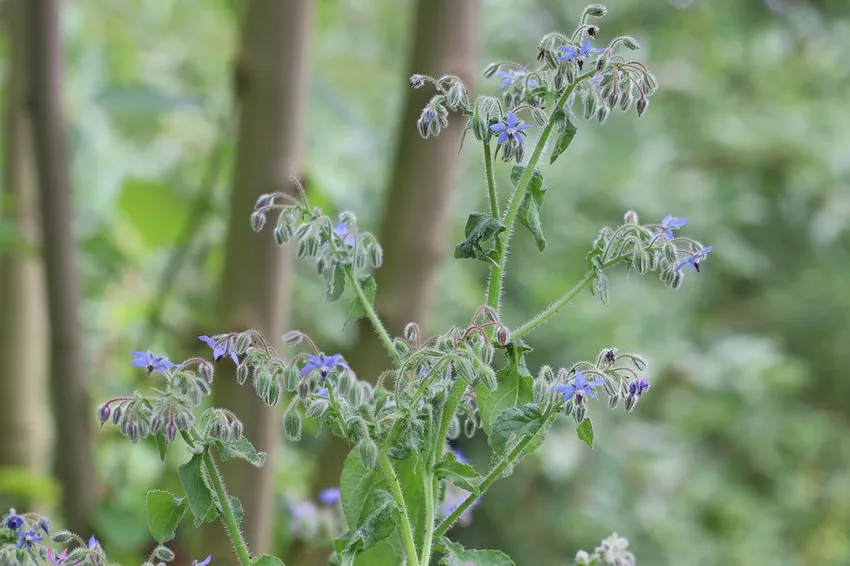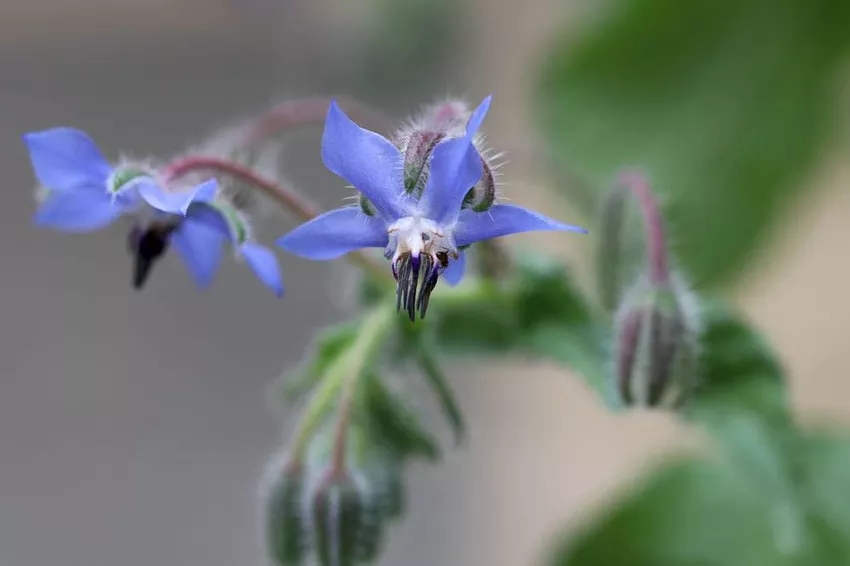
Borage (botanical: Borago officinalis) is also known as cucumber or kukumer herb and is used as a spice and medicinal plant. The beautiful blue flowers provide color in the garden and on balconies. But Borago officinalis is said to be poisonous and therefore not entirely harmless to consume. Plantopedia explains what this is all about and whether there are any special features to consider with the garden herb.
borage
Toxic ingredients
Borago officinalis contains so-called alkaloids, to be more precise pyrrolizidine alkaloids. This is a toxic substance that can also be found in numerous other predatory leaf plants, such as viper's bugloss or comfrey. Pyrrolizidine alkaloids are composed of the following substances, each of which has toxic properties.
- amabiline
- intermediate
- lycopsamine
- supinine
- thesinine
 Borage, Borago officinalis
Borage, Borago officinalis
Alkaloids definition
at alkaloids It is a natural plant repellant. This is one of the secondary plant substances and is widespread in the plant world. They even occur in green and various herbal tea(s). Although there is no biological evidence to date, it is assumed that their eco-chemical function is to protect the plant from predators and various pathogens.
the toxicity of alkaloids has been known to science for more than a century. There is no ban on trading in products and plants containing alkaloids. The latter are on the lists of poisonous plants, such as borage, which would have to be consumed in large quantities to cause damage to health.
effect on health
Possible alkaloid health effects
Scientific studies have shown that large amounts of alkaloids can have a harmful effect on the liver cells. So it can become one disturbance for example the fat metabolism and the bile acid secretion. At the Federal Institute for Risk Assessment, BfR for short, the scientists suspect that alkaloids, such as those found in Borago officinalis, can also have carcinogenic properties.
When harvesting or collecting borage from wild herb meadows, touching the leaves can be too easy skin irritation to lead.
 Borage, Borago officinalis
Borage, Borago officinalis
Establishment of alkaloids in Borago officinalis
Pyrrolizidine alkaloids can be found in the leaves, stems and flowers of borage. The flower seeds are (almost) free of the substance. For example, borage oil is pressed from them, which is therefore non-toxic.
toxicity
Dose determines toxicity
The investigations of the Federal Institute for Risk Assessment have shown that small amounts of Borago officinalis can be taken safely. For an adult with a body weight of 60 kilograms, the consumption of up to 0.42 micrograms of pyrrolizidine alkaloids per day has no adverse health effects.
One kilogram of borage can contain up to 150 micrograms. That is, the daily dose should not exceed around three grams of borage. It is therefore advisable to pay close attention to the amount of borage, which is also often found in various ready-made sauces and salad dressings. If the fresh borage from the garden is also used for a smoothie, the recommended daily dose can quickly be exceeded.
NOTICE: Contrary to popular belief, alkaloids cannot be destroyed by cooking.
exceptions
Although occasional and well-dosed consumption of borage is not toxic for a healthy adult, this is not necessarily the case for pregnant and breastfeeding women and small children.
The toxins, even if only in small amounts, can be transmitted to the unborn child and passed into breast milk. Both in these cases and in young children, sensitivity to alkaloids significantly higher and a health hazard cannot be ruled out. For this reason, the following applies: during pregnancy, breastfeeding and when preparing food for small children, completely avoid Borago officinalis!
 Borage, Borago officinalis
Borage, Borago officinalis
Toxic to pets?
Borage is not listed as a plant poisonous to cats or dogs. As a rule, there is a maximum of a short nibble, during which only a very small amount of alkaloids can be absorbed. included bitter substances make the plant unattractive for pets at the latest on the second attempt at consumption. Therefore, it cannot be assumed that cucumber herb poses a health risk for pets.
weed
Borage as a wild herb
Collecting wild herbs is becoming increasingly popular. In some cases, there is a lack of knowledge about what herbs can really be used or what kind of herbs are involved. Since that predatory-leaf plant self-propagated, it can also be found in the wild. In order to be able to recognize the cucumber herb between other wild herbs, here are a few typical characteristics.
- Growth height up to a maximum of 70 centimeters
- bristly hairy stems and leaves
- Leaves are dark green and coarse in structure
- lanceolate to ovate leaves
- Leaf length between ten and fifteen centimetres
- blooms from May to September
- blue flower on a pedicel about three centimeters long
- hermaphrodite, five-petaled calyx
- double perianth
- young petals only pink
site selection
Observe when planting and cultivating
When choosing a location in the garden, care should be taken to ensure that there is sufficient distance to the plant neighbors in the herb bed. An "overlapping" of borage leaves onto others leaf herbs could result in them being accidentally plucked off when harvesting the neighboring herbs and being processed in dishes unnoticed. If the cucumber herb is then consumed in a targeted manner, the recommended daily dose could be exceeded.
Furthermore, care should be taken to ensure that small children do not get to the plant unnoticed and, if necessary, nibble on the leaves or flowers. Accordingly, borage should be planted or cultivated in such a way that small children have no free/exclusive access.
 Borage, Borago officinalis
Borage, Borago officinalis
Conclusion
Cucumber herb is poisonous when consumed in large quantities. Since it is very taste intensive is, usually not much of the herb is used, so that the occasional consumption or small daily consumption is completely harmless and even good for the health due to healthy ingredients such as vitamins, mucilage and omega-3 fatty acids. In the manufacture of the borage oil do not have to be concerned about toxicity.